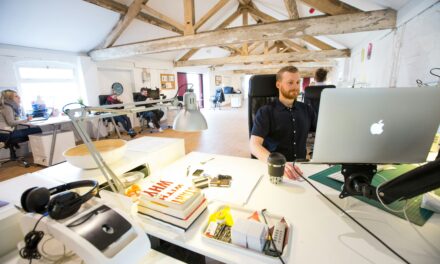In today’s fast-paced world, stress has become an inevitable part of our lives. Whether working from home or in a traditional office setting, stress at work can significantly impact your mental and physical health.
Fortunately, several relaxation techniques can help reduce stress and increase productivity, creating a more positive and enjoyable work environment.
This article will explore some effective relaxation techniques you can implement in your workspace to reduce stress and improve your overall well-being.
The Impact of Stress on Work Productivity
The impact of stress on work productivity cannot be overstated. Stress can affect an individual’s work in several ways. For example, stress can lead to decreased motivation, resulting in reduced productivity. Stress can also cause an individual to feel overwhelmed, leading to an inability to focus on work.
Additionally, workplace stress can lead to physical symptoms, such as headaches and fatigue, making it difficult for an individual to complete their work efficiently. Furthermore, stress can lead to absenteeism, resulting in a company’s productivity loss.
To shed more light on the complex interplay between workplace stress and disengagement, check out this in-depth guide on how to overcome employee turnover.
Individuals and companies need to understand the impact of stress on work productivity to manage stress in the workplace effectively. One way to do this is to create a work environment conducive to relaxation and stress reduction. This can include creating a quiet and comfortable workspace, reducing noise levels, providing access to natural light, and allowing for breaks throughout the workday.
Another way to manage stress in the workplace is to provide employees with resources and support to help them cope with stress. This can include counseling services, wellness programs, and flexible work arrangements.
Additionally, companies can encourage employees to engage in stress-relieving activities, such as yoga, meditation, and exercise. Implementing virtual desktop infrastructure (VDI) solutions can also contribute to reducing stress and enhancing work productivity. VDI enables employees to access their work desktops and applications from any device with an internet connection.
This flexibility allows individuals to work remotely or from different locations, providing a better work-life balance and reducing the stress associated with commuting or strict office hours.
Ultimately, managing stress in the workplace is essential not only for individual employees but also for the success of the company as a whole. By understanding the impact of stress on work productivity and taking steps to reduce stress in the workplace.

Types of Relaxation Techniques
Physical relaxation techniques
Physical relaxation techniques are practices aimed at preventing and reducing the muscle tension associated with stress. Progressive muscle relaxation, deep breathing exercises, and yoga are some of the most popular physical relaxation techniques used in today’s workforce. Progressive muscle relaxation involves tensing and then releasing the muscles of each body part in sequence, starting from the toes and working up to the head.
The process forces the practitioner to recognize and release physical tension, resulting in more profound relaxation. Deep breathing exercises, on the other hand, encourage the practitioner to take slow, deep breaths from the diaphragm. Such breathing slows the heart rate and lowers blood pressure, which helps to reduce tension and promote relaxation.
Last but not least, yoga combines physical postures, breathing techniques, and meditation to help practitioners increase strength and flexibility, as well as promote relaxation.
Mental relaxation techniques
Mental relaxation techniques refer to the methods used to reduce stress and anxiety by focusing on the mind. These techniques are effective because they can be used anywhere, at any time, and do not require special equipment or tools. Meditation, visualization, and autogenic training are three of the most widespread mental relaxation techniques.
Meditation involves quieting the mind and focusing on the present moment. This technique has been around for thousands of years and effectively reduces stress, anxiety, and depression. During meditation, a person sits comfortably and focuses on their breath, a sound, or an image. As thoughts come up, the person gently acknowledges them and returns their focus to their breath, sound, or image.
Visualization involves using mental imagery to create a sense of calm and well-being. This technique consists in creating a picture of a relaxing scene, such as a beach or a forest, and imagining oneself in that environment. Many people find that visualization helps them to feel more relaxed and centered and can be a valuable tool for reducing stress and anxiety.

Benefits of Relaxation Techniques in the Workplace
Reduced stress levels
Reducing stress levels in the workplace is crucial for employee health, productivity, and overall satisfaction. Implementing relaxation techniques such as deep breathing, meditation, or yoga can significantly lower stress levels. These techniques help regulate the body’s response to stress, decreasing the production of stress hormones and promoting relaxation.
Employers can create a positive and productive work environment by incorporating relaxation techniques. When stress levels are reduced, employees feel calmer, focused, and energized. This leads to improved overall health and mental health. Lower stress levels can enhance sleep quality, boost the immune system, and increase resilience to stressors.
In addition, employers can leverage the power of targeted Facebook ads to promote wellness programs and resources, reaching employees more effectively and increasing their engagement in stress-reducing activities.
Employees who feel supported and valued are likelier to be engaged and committed to their work. Relaxation techniques can improve job satisfaction, reduce absenteeism, and increase employee retention.
Improved focus and concentration
One of the most successful ways to improve focus and concentration is to employ relaxation techniques in the workspace to reduce stress levels. By reducing stress, the mind can better focus on the task without undue distractions. Techniques like deep breathing exercises, meditation, and yoga stretches release physical tension that affects the brain’s cognitive functioning, allowing for greater productivity and improved concentration.
Progressive muscle relaxation is another effective technique that can be easily integrated into the workday. This technique entails sequentially tensing and releasing muscle groups, leading to profound relaxation and greater focus.
Research has shown that practicing mindfulness-based stress reduction exercises and relaxation techniques can reduce perceived stress, improving overall job satisfaction and elevated mood. Stress levels can be diminished by making relaxation techniques a part of everyday office life, and focus and productivity can increase, leading to positive workplace outcomes.
Increased productivity
The benefits of reducing workplace stress extend beyond just feeling better; they can also translate into increased productivity. Employees can improve their mental health and focus by utilizing relaxation techniques, leading to better work performance.
When stress levels are high, it can be challenging to concentrate on work-related tasks, leading to decreased productivity and lower-quality work output. However, by incorporating relaxation techniques into their daily routine, employees can lower their stress levels and improve their ability to focus. This, in turn, can result in increased productivity, allowing employees to complete tasks more efficiently and effectively.
One popular relaxation technique that can help increase productivity is deep breathing exercises. By taking slow, deep breaths and focusing on their breathing, employees can calm their minds and reduce feelings of stress or anxiety. This can help them feel more centered and focused on the task, allowing them to work more efficiently and productively.
In the cases where employees need to take care of serious tasks or issues such as finding a good SPF record checker for emails or learning about cybersecurity, it’s important to keep the productivity flow going.
Improved overall well-being
Utilizing relaxation techniques in the workplace can improve employees’ overall well-being. When stress levels are reduced through relaxation, employees may experience an alleviation of physical and mental symptoms associated with stress, including headaches, muscle tension, and anxiety.
By prioritizing relaxation in the workplace, employees can experience multiple benefits that can positively impact their personal and professional lives. This stress reduction can also improve sleep quality and a sense of calmness and serenity.

Relaxation Techniques in a Workspace – FAQ
What relaxation techniques can the workspace use to reduce stress?
Various relaxation techniques can be utilized in the workspace to reduce stress, including deep breathing exercises, progressive muscle relaxation, visualization, and guided imagery.
While a toxic work environment can often cause high stress, regular breaks, and relaxation techniques can help employees become more resilient in challenging or demanding situations.
Is practicing mindfulness an effective method for reducing workplace stress?
Yes, practicing mindfulness is an effective method for reducing workplace stress. Mindfulness involves staying present at the moment and can be practiced through activities like meditation and yoga.
Can listening to music help reduce workplace stress?
Yes, listening to calming music can help reduce workplace stress. Choose instrumental music with a calming effect, and try to listen with headphones to minimize distractions.
What is journaling, and how can it help reduce workplace stress?
Journaling is writing down thoughts and feelings in a journal or notebook. This can help reduce workplace stress by providing an outlet for emotions, increasing self-awareness, and helping to process difficult experiences.
Can taking breaks throughout the workday help reduce workplace stress?
Yes, taking breaks throughout the workday can help reduce workplace stress. It is essential to take short breaks to stretch, walk, or do something enjoyable to help you relax and recharge.
Are there any workplace policies or programs that can help reduce stress?
Yes, some workplaces have policies and programs to help reduce workplace stress. These may include flexible work schedules, wellness, and employee assistance programs. Checking with your employer to see available resources is a good idea.
Conclusion
Utilizing relaxation techniques in the workspace provides numerous benefits for both employees and employers. Some of the most significant benefits of relaxation at work include increased productivity, reduced stress levels, lowered anxiety, and enhanced employee morale.
Employees who take breaks to practice relaxation techniques return to their work feeling refreshed and re-energized, allowing them to be more focused and productive in their tasks. Additionally, reducing stress levels can improve employees’ overall health, reducing the number of sick days taken and increasing employee retention rates.
These benefits highlight the importance of implementing relaxation techniques in the workplace to reduce stress and promote a healthier, more productive work environment.









